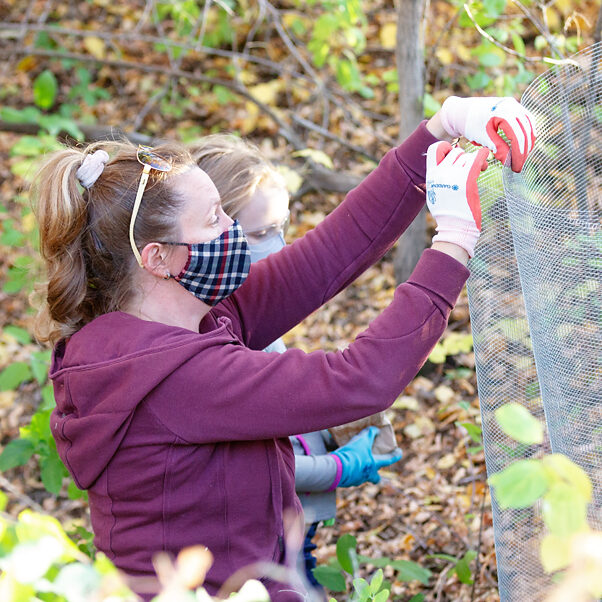Meewasin exists to ensure a healthy and vibrant river valley, with a balance between human use and conservation. A prime example of where Meewasin’s expertise is required to strike this balance is between the cute, furry, orange-toothed, tree-cutting rodents known as beavers, and fallen, cut-down trees, which could pose a potential danger to visitors of the Meewasin Trail.
Eager Beavers Get the Tree
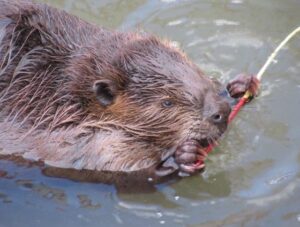
Meewasin recognizes that beavers are a very important species to the Meewasin Valley, and celebrates that they are denoted as a keystone species in our area because their work provides shelter and habitat for many other species.
As a native species to the Meewasin Valley and region, beavers have been creating their homes and feeding their families with trees in their habitat for many thousands of years, and will continue to do so.
Check out this Creature Feature video all about the importance of beavers, the place they have in the city and valley, as well as their need to take down trees to survive.
Leaf that Tree Alone!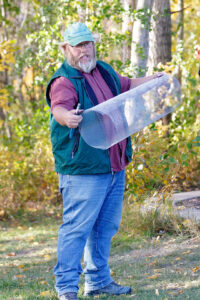
Meewasin and the City of Saskatoon annually introduce many trees throughout the valley and in urban areas for many reasons; a few being that countless studies show that humans greatly benefit from trees in their environment, and the fact that trees provide a beneficial canopy in urban areas.
Some trees in vulnerable areas (for example, if they were to fall could injure someone on the trail) and those that are of higher value from being invested in with carefully planting and protection, are the type of trees that need to be protected from beavers.
A method to finding a proper balance of safety, protection and conservation, is to cover these trees with protective mesh that the beavers are not able to climb over or chew through to get to it. Meewasin uses chicken wire-looking protective mesh that the beavers cannot chew through and is placed in a method that won’t girdle the tree.
Branching Out
This fall, Meewasin hosted a physically distant, outdoor volunteer event where participants helped to wrap trees with the protective mesh. We had just under 30 volunteers join us from the community, different organizations, and many participants from WILD Outside, a new conservation leadership program developed by the Canadian Wildlife Federation and funded by the Government of Canada through the Canada Service Corps initiative., where youth aged 15 – 18 get together to enjoy outdoor activities and serve their commu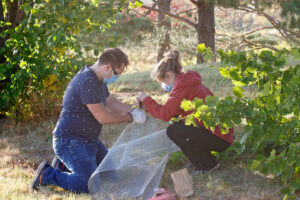 nities through conservation projects.
nities through conservation projects.
One volunteer from WILD Outside, Elisabeth, shares some thoughts about the impact “Such conservation efforts should serve the entire local ecosystem. This includes plants and animals, as well as people. We successfully balanced all three aspects; the beavers have enough food, native trees can thrive and the trail is protected from future tree obstructions. It was such a treat to conclude the event by watching beavers swim near their lodge.”
Another WILD Outside volunteer, Graeme, notes with pride that “Non-destructive 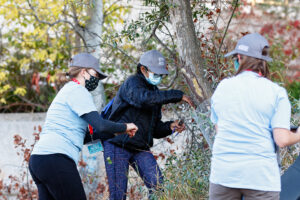 methods, like tree-wrapping, can help provide a permanent solution. I think that tree-wrapping is an effective strategy. It prevents beavers from cutting down trees valued by the landowners, while still allowing the ecosystem those trees are a part of to flourish.” Graeme continues with some advising words, “I think that the public has a huge role to play in good urban-wildlife interaction. I believe it is our responsibility to be stewards of the natural world around us. With the help of the public, so much more progress in wildlife conservation can be made.”, he goes on to describe the impact wildlife can have people, “…Sometimes it can be the wildlife that helps us. My experience tree-wrapping was great, and one of the many highlights was being able to see the beaver family and other wildlife nearby. If people can gain a deeper understanding of the natural world through experiencing it, they can be more driven to help conserve it. The charismatic beaver can be an ambassador to the entire natural world, inspiring people young and old to become responsible stewards and benefactors of nature”
methods, like tree-wrapping, can help provide a permanent solution. I think that tree-wrapping is an effective strategy. It prevents beavers from cutting down trees valued by the landowners, while still allowing the ecosystem those trees are a part of to flourish.” Graeme continues with some advising words, “I think that the public has a huge role to play in good urban-wildlife interaction. I believe it is our responsibility to be stewards of the natural world around us. With the help of the public, so much more progress in wildlife conservation can be made.”, he goes on to describe the impact wildlife can have people, “…Sometimes it can be the wildlife that helps us. My experience tree-wrapping was great, and one of the many highlights was being able to see the beaver family and other wildlife nearby. If people can gain a deeper understanding of the natural world through experiencing it, they can be more driven to help conserve it. The charismatic beaver can be an ambassador to the entire natural world, inspiring people young and old to become responsible stewards and benefactors of nature”
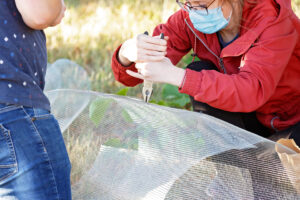 To add some further insight into the tree wrapping, volunteer from the WILD Outside crew, Katrina, explained some of the strategy that was implemented: “The concept that I really approve about this tree wrapping event was keeping the eco-balance. Though the purpose of this event was to protect trees from hunting beavers, we also respected the fact that beavers need to survive too. Therefore, we intentionally only wrapped the trees growing on the east side of the pond, leaving the west side trees for the beavers.”
To add some further insight into the tree wrapping, volunteer from the WILD Outside crew, Katrina, explained some of the strategy that was implemented: “The concept that I really approve about this tree wrapping event was keeping the eco-balance. Though the purpose of this event was to protect trees from hunting beavers, we also respected the fact that beavers need to survive too. Therefore, we intentionally only wrapped the trees growing on the east side of the pond, leaving the west side trees for the beavers.”
WILD Outside Youth Leader, Raea Gooding, had some interesting observations about the activity as well, “As evidenced during our tree wrapping event on September 24th, everyone enjoys watching the beavers – they drew quite a crowd from volunteers and passers-by alike! I think urban wildlife management is a group effort, requiring citizens, organizations, and decision makers to be knowledgeable and responsible with wildlife. If those that appreciate seeing wildlife are educated on issues and potential solutions, and become part of the discussion, we can make sure we are creating a future of urban wild that works for everyone.”
To Wrap It All Up
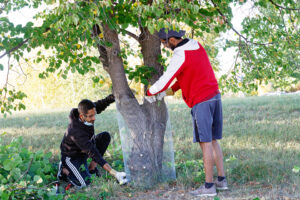
We want to once again thank all of the amazing volunteers who joined us at the event and helped set up wrapping around the trees behind the Diefenbaker Centre in the Meewasin Valley. The trees and visitors to the trail will be able to enjoy the area without fear that the trees will fall on the trail or be gone due to resourceful beavers! Listen to the CBC radio interview with Meewasin’s Manager of Planning and Conservation, Mike Velonas, about the tree wrapping event. Join our volunteer list to hear about upcoming opportunities to get involved with Meewasin!




